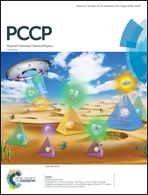Spin–orbit interaction and Renner–Teller effect in HCCCCH+ studied by high-resolution photoelectron spectroscopy
Abstract
The photoelectron spectra of the X+ 2Πg ← X 1Σ+g photoionizing transition of diacetylene (HCCCCH) and d2-diacetylene (DCCCCD) have been recorded at high resolution using the technique of pulsed-field-ionization zero-kinetic-energy (PFI-ZEKE) photoelectron spectroscopy. The partially resolved rotational structure of the origin band of the spectra of HCCCCH and DCCCCD has enabled the determination of the adiabatic ionization energies of HCCCCH [Ead = 82072.2(5) cm−1] and DCCCCD [Ead = 82090.0(10) cm−1] and of the spin–orbit coupling constant [A+0 = −31.1(4) cm−1] of the ground vibronic state of HCCCCH+, which is smaller than the value of −33.3 cm−1 commonly used since the work of Callomon (J. H. Callomon, Can. J. Phys., 1956, 34, 1046). Several excited vibrational levels of HCCCCH+ and DCCCCD+, including some affected by the Renner–Teller effect and Fermi interactions, have been observed and the fundamental wavenumber of the mode ν9 has been determined in both HCCCCH+ (200.0(10) cm−1) and DCCCCD+ (192.6(20) cm−1). Possible assignments for several of these levels are discussed and deficiencies in the current understanding of the energy-level structure of the radical cation of diacetylene are pointed at.



 Please wait while we load your content...
Please wait while we load your content...